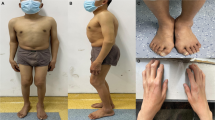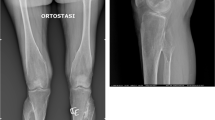Abstract
Purpose
Multiple hereditary exostoses (MHE) is a rare autosomal dominant condition that results in the growth of cartilage-capped prominences that often cause nerve compression and injury. Many patients suffer from continued and debilitating chronic pain which leads some to advocate avoiding surgical intervention in patients with multiple hereditary exostoses. We present a review of the literature as well as a case series at our institution in order to evaluate the role of surgery in multiple hereditary exostoses.
Methods
We searched the literature for reports of patients with multiple hereditary exostoses undergoing surgery for nerve compression. We then reviewed the recent experience at our institution which revealed two patients with multiple hereditary exostoses.
Results
Our literature search revealed that there have been several case series and retrospective analyses in the literature that assess the benefit of surgery in the case of nerve compression caused by exostoses. The majority of these reports are of solitary exostoses. Few reports expand on the role of surgery in patients with multiple hereditary exostoses suffering from nerve compressions secondary to bony overgrowth. A recent review of the experience at our institution revealed two patients with multiple hereditary exostoses who together underwent a total of four surgeries for treatment of peripheral nerve compression resulting in pain or weakness. Postoperative evaluation revealed improvement in pain and/or motor strength following each operation.
Conclusion
Based on our experience and literature review, we advocate that nerve compression in selected individuals with multiple hereditary exostoses that results in neurological injury should be considered for nerve decompression and resection of the offending exostosis.


Similar content being viewed by others
References
Pannier S, Legeai-Mallet L (2008) Hereditary multiple exostoses and enchondromatosis. Best Pract Res Clin Rheumatol 22:45–54. doi:10.1016/j.berh.2007.12.004
Stieber JR, Dormans JP (2005) Manifestations of hereditary multiple exostoses. J Am Acad Orthop Surg 13:110–120
Marshall HW (1916) A case of multiple cartilaginous exostoses. JBJS Case Connect 14:346–359
Legeai-Mallet L, Munnich A, Maroteaux P, Le Merrer M (1997) Incomplete penetrance and expressivity skewing in hereditary multiple exostoses. Clin Genet 52:12–16
Flores LP, Koerbel A, Tatagiba M (2005) Peroneal nerve compression resulting from fibular head osteophyte-like lesions. Surg Neurol 64:249–252. doi:10.1016/j.surneu.2004.11.031
Slepian A, Hamby WB (1951) Neurologic complications associated with hereditary deforming chondrodysplasia: review of the literature and a report of two cases occurring in the same family. J Neurosurg 8:529–535
Göçmen S, Topuz AK, Atabey C, et al. (2014) Peripheral nerve injuries due to osteochondromas: analysis of 20 cases and review of the literature. J Neurosurg 120:1105–1112. doi:10.3171/2013.11.JNS13310
Wicklund CL, Pauli RM, Johnston D, Hecht JT (1995) Natural history study of hereditary multiple exostoses. Am J Med Genet 55:43–46. doi:10.1002/ajmg.1320550113
Burki V, SO A, Aubry-Rozier B (2011) Cervical myelopathy in hereditary multiple exostoses. Jt Bone Spine 78:412–414. doi:10.1016/j.jbspin.2011.02.021
Aldea S, Bonneville F, Poirier J, et al. (2006) Acute spinal cord compression in hereditary multiple exostoses. Acta Neurochir (Wien) 148:195–198. doi:10.1007/s00701-005-0680-6
Bess RS, Robbin MR, Bohlman HH, Thompson GH (2005) Spinal exostoses: analysis of twelve cases and review of the literature. Spine (Phila Pa 1976) 30:774–780. doi:10.1097/01.brs.0000157476.16579.a2
Gray KV, Robinson J, Bernstein RM, Otsuka NY (2004) Splitting of the common peroneal nerve by an osteochondroma: two case reports. J Pediatr Orthop Part B / Eur Paediatr Orthop Soc Pediatr Orthop Soc North Am 13:281–283. doi:10.1097/01.bpb.0000111022.13276.0a
Govender S, Parbhoo AH (1999) Osteochondroma with compression of the spinal cord. A report of two cases. J Bone Joint Surg Br 81:667–669. doi:10.1302/0301-620X.81B4.9248
Paik NJ, Han TR, Lim SJ (2000) Multiple peripheral nerve compressions related to malignantly transformed hereditary multiple exostoses. Muscle Nerve 23:1290–1294. doi:10.1002/1097-4598(200008)23:8<1290:AID-MUS23>3.0.CO;2-M
Nunez DA, Graham HK, Fixsen JA (1990) Cervical cord compression and femoral neuropathy in hereditary multiple exostoses. J Neurol Neurosurg Psychiatry 53:439. doi:10.1136/jnnp.53.5.439
Ashraf A, Larson AN, Ferski G, et al. (2013) Spinal stenosis frequent in children with multiple hereditary exostoses. J Child Orthop 7:183–194. doi:10.1007/s11832-013-0484-9
Tian Y, Yuan W, Chen H, Shen X (2011) Spinal cord compression secondary to a thoracic vertebral osteochondroma. J Neurosurg Spine 15:252–257. doi:10.3171/2011.4.SPINE10484
Zaijun L, Xinhai Y, Zhipeng W, et al. (2013) Outcome and prognosis of myelopathy and radiculopathy from osteochondroma in the mobile spine: a report on 14 patients. J Spinal Disord Tech 26:194–199. doi:10.1097/BSD.0b013e31823eb239
Goud AL, de Lange J, Scholtes VAB, et al. (2012) Pain, physical and social functioning and quality of life in individuals with multiple hereditay exostoses in the Netherlands. J Bone Jt Surg 94:1013. doi:10.2106/JBJS.K.00406
Darilek S, Wicklund C, Novy D, et al. (2005) Hereditary multiple exostosis and pain. J Pediatr Orthop 25:369–376. doi:10.1097/01.bpo.0000150813.18673.ad
Bottner F, Rodl R, Kordish I, et al. (2003) Surgical treatment of symptomatic osteochondroma. A three-to eight-year follow-up study. J Bone Joint Surg Br 85:1161–1165. doi:10.1302/0301-620X.85B8.14059
Cardelia JM, Dormans JP, Drummond DS, et al. (1995) Proximal fibular osteochondroma with associated peroneal nerve palsy: a review of six cases. J Pediatr Orthop 15:574–577. doi:10.1097/01241398-199509000-00004
Karakurt L, Yilmaz E, Varol T, et al. (2004) Solitary osteochondroma of the elbow causing ulnar nerve compression: a case report. Acta Orthop Traumatol Turc 38:291–294
Yu K, Meehan JP, Fritz A, Jamali AA (2010) Osteochondroma of the femoral neck: a rare cause of sciatic nerve compression. Orthopedics. doi:10.3928/01477447-20100625-26
Murphy SM, Browne K, Tuite DJ, O’Shaughnessy M (2013) Dual pathology proximal median nerve compression of the forearm. J Plast Reconstr Aesthet Surg 66:1792–1794. doi:10.1016/j.bjps.2013.04.054
Turan Ilica A, Yasar E, Tuba Sanal H, et al. (2008) Sciatic nerve compression due to femoral neck osteochondroma: MDCT and MR findings. Clin Rheumatol 27:403–404. doi:10.1007/s10067-007-0761-4
Ryckx A, Somers JF, Allaert L (2013) Hereditary multiple exostosis. Acta Orthop Belg 79:597–607
Scmale GA, Conrad EU, Raskind WH (1994) The natural history of hereditary multiple exostoses. J Bone Joint Surg Am 76:986–992
Jones KB (2012) Glycobiology and the growth plate: current concepts in multiple hereditary exostoses. J Pediatr Orthop 31:577–586. doi:10.1097/BPO.0b013e31821c7738
Muthusamy S, Conway SA, HT T (2014) Five polyostotic conditions that general orthopedic surgeons should recognize (or should not miss). Orthop Clin North Am 45:417–429. doi:10.1016/j.ocl.2014.04.004
Bovee JVMG (2008) Multiple osteochondromas. Orphanet J Rare Dis 3:3. doi:10.1186/1750-1172-3-3
Czajka CM, DiCaprio MR (2015) What is the proportion of patients with multiple hereditary exostoses who undergo malignant degeneration? Clin Orthop Relat Res. doi:10.1007/s11999-015-4134-z
Çınar A, Yumrukçal F, Salduz A, et al. (2014) A rare cause of “drop foot” in the pediatric age group: proximal fibular osteochondroma a report of 5 cases. Int J Surg Case Rep 5:1068–1071. doi:10.1016/j.ijscr.2014.09.024
Yoo JH, Min KD, Kim CK, Cha JG (2010) A case of extension loss of great toe due to peroneal nerve compression by an osteochondroma of the proximal fibula. Arch Orthop Trauma Surg 130:1071–1075. doi:10.1007/s00402-009-0944-3
Levin KH, Wilbourn AJ, Jones HR (1991) Childhood peroneal neuropathy from bone tumors. Pediatr Neurol 7:308–309. doi:10.1016/0887-8994(91)90053-N
Mnif H, Koubaa M, Zrig M, et al. (2009) Peroneal nerve palsy resulting from fibular head osteochondroma. Orthopedics 32:528. doi:10.3928/01477447-20090527-24
Levine PA, Frierson HF, Stewart FM, et al. (1987) Sinonasal undifferentiated carcinoma: a distinctive and highly aggressive neoplasm. Laryngoscope 97:905–908
Acknowledgments
No financial or material support has been received.
Author information
Authors and Affiliations
Corresponding author
Ethics declarations
Conflict of interest
The authors have nothing to disclose.
Additional information
Portions of this work were present as a poster at the 2015 Pennsylvania Neurosurgical Society meeting in Hershey, PA.
Rights and permissions
About this article
Cite this article
Payne, R., Sieg, E., Fox, E. et al. Management of nerve compression in multiple hereditary exostoses: a report of two cases and review of the literature. Childs Nerv Syst 32, 2453–2458 (2016). https://doi.org/10.1007/s00381-016-3166-3
Received:
Accepted:
Published:
Issue Date:
DOI: https://doi.org/10.1007/s00381-016-3166-3




